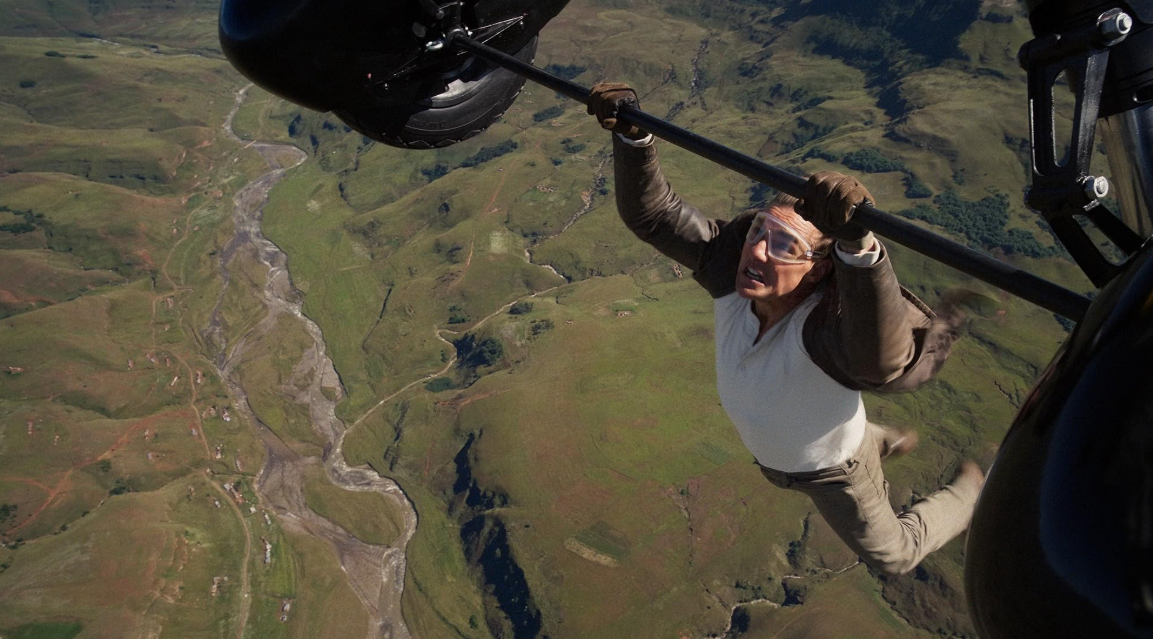Images courtesy of Paramount Pictures
MISSION: IMPOSSIBLE – THE FINAL RECKONING– 4 STARS
LESSON #1: THE GARROLOUS DESCRIPTIONS NEVER FAIL—With each new escalating entry in the Mission: Impossible franchise, the orotund and descriptive words used by supporting characters to describe Tom Cruise’s Ethan Hunt get better and more severe every time. In a citation from two years ago in this critic’s space for the review of Mission: Impossible – Dead Reckoning that bears repeating, Alec Baldwin enunciated his string of zingers back in Mission: Impossible – Rogue Nation from 2015 to say:
“Hunt is uniquely trained and highly motivated – a specialist without equal – immune to any countermeasures. There is no secret he cannot extract, no security he cannot breach, no person he cannot become. He has most likely anticipated this very conversation and is waiting to strike in whatever direction we move. Sir, Hunt is the living manifestation of destiny – and he has made you his mission.”
In the last movie, Shea Whigham’s government pursuer Jasper Briggs—now working for the original’s internal heavy Eugene Kittridge (Henry Czerny) in second-half—took Baldwin’s words further and coarser, issuing this stern warning to his subordinate operatives:
“He is not to be underestimated: a master of infiltration, deception, sabotage and psych warfare. For all intents and purposes, ladies and gentlemen, (he is) a mind-reading, shape-shifting incarnation of chaos. So, for your safety and the safety of those around you, do not consider him secure unless you have driven a wooden stake through his open heart. This is not a drill.”
From “living manifestation of destiny” to “mind-reading, shape-shifting incarnation of chaos,” the pedestal positioning of Ethan Hunt—and therefore Tom Cruise—playing him has only gotten taller and taller, much like the heights the actor scales with his stunts. Here, at the announced finishing chapter of Mission: Impossible – The Final Reckoning of the now-iconic character enduring nearly thirty years in our cinematic lives, we’ve witnessed the progression of him as a top spy with more lives than a litter of cats to something far more starry and radiant. More on that later.
Since the conclusion of Mission: Impossible – Dead Reckoning, the truth-eating artificial intelligence parasite, The Entity, has infiltrated the world’s cyberspace and seized control of the nuclear stockpiles of a handful of smaller countries. The last nations with secure arsenals are the United Kingdom, Russia, China, and the United States, but those digital walls are crumbling by the day. Moreover, The Entity’s anti-utopian aim has created worldwide paranoia and spawned cults and mobs of fanatical followers, leading to martial law statuses in several major metropolitan areas. It seeks division and panic, demanding superpowers to surrender before launching a cross-crossed atomic apocalypse that would raze humanity from the planet.
All of this stage-setting and catch-up exposition is presented to Ethan Hunt in the pre-credits opening through a VHS tape message sent by Erika Sloane (the returning Angela Bassett), the former Director of the CIA from Mission: Impossible – Fallout, who is now the President of the United States of America. Slowed but not deterred by the many analog contingencies and workarounds to avoid the omnipresent Entity online, President Sloane demands that Ethan Hunt stand down, report in, and surrender the two-part cruciform key retrieved by him and his new thief partner, Grace (Hayley Atwell), that could be used to control The Entity.
The first third of Mission: Impossible – The Final Reckoning lays out the difficulty methodically. The key opens a shielded room containing the source code drive of The Entity. However, that’s on a sunken Russian submarine that no one can find in a Bering Sea teeming with U.S. and Russian naval vessels. If they could get that drive, Ethan’s fiercely loyal hacker, Luther Stickell (fellow series original Ving Rhames), has created a poison pill to neutralize it. Meanwhile and concurrently to the nuclear takeover, The Entity and its zealous acolyte Gabriel (veteran TV actor Esai Morales), spouting more platitudes of foreboding menace, seek to infiltrate the massive underground data archive of the Doomsday Vault in South Africa as a place to hide during the centuries following the impending nuclear extinction.
LESSON #2: WHAT’S THE PLAY?— Naturally and with a mere three days to work with, Ethan Hunt is the only individual on Earth capable of these precarious and necessary steps. But we’re talking about Ethan Hunt, the “you always do” expert in always having a plan. Merely ask “What’s the play?” and the clandestine genie—looking a shade more shaggy in the hair and eyes at his seasoned age—comes out of the bottle to make it happen with his crack team in tow. Matching some of the shortcut layering used throughout the film series, director Christopher McQuarrie’s go-to editor Eddie Hamilton splices the execution of the wild plans next to the spoken explanation of their preparation.
With that, the dynamite fuses are lit, and the electronically dominant musical score from Max Aruj and Alfie Godfrey (two close collaborators of composer Lorne Balfe, who covered Mission: Impossible – Fallout and Mission: Impossible – Dead Reckoning) takes over. Just when you think this franchise couldn’t get any bigger with its ambition, just when you think more series-wide connections from its legacy couldn’t be squeezed into this culmination, and just when you think Tom Cruise can’t top himself in the daredevil department, Mission: Impossible – The Final Reckoning answers. Director Christopher McQuarrie unfurls one superior action sequence after another.
The promise of enormous spectacle in Mission: Impossible – The Final Reckoning is more than answered by the tireless production teams highlighted by several integral departments. Like the art of Joan Miró, the predominantly practical action arrives by land, sea, and air, while Industrial Light and Magic blurs any seams digitally. Second unit director and stunt coordinator Wade Eastwood (working his seventh film for Tom Cruise) puts cinematographer Fraser Taggert’s (a former second unit director himself) camera on every rig possible to capture footage of brutal hand-to-hand fights and amazing vehicular feats. Marine coordinator Neil Andrea (The Little Mermaid) provides the prerequisite breathless scene that involves silence from the sound department, while aerial coordinator Steven Moth (No Time to Die) pins our ears back and lets our matinee idol get all Bessie Coleman on the outside of biplanes before it’s all said and done. Seek out the biggest and loudest theater possible for the full sensory immersion, sure to explode an auditorium full of heart monitors.
LESSON #3: A CLASSIC CASE OF THE SAVIOR COMPLEX— Firmly stated, the plot of Mission: Impossible – The Final Reckoning requires no less than a miraculous savior. One authority figure after another in this film sheds their insistence on protocols, analyzed outcomes, and political morals to rest their fate and the world’s on—guess who—Ethan Hunt, the man in the shows and the hero known to no one in the general public. More so than any previous film, the stakes are existentially dire, and all roads of success, fault, and even prophecy flow through Ethan. Employed as a last resort and branded with the “only man for the job” trope, he embodies the label given to him of “the best of men at the worst of times.” As if anyone needed an actual psychologist to diagnose the character officially before now, a case of The Savior Complex is alive and well at 62 years old.
Make no mistake, the Savior Complex stretches beyond the hefty 169-minute running time of Mission: Impossible – The Final Reckoning as well to the authoritative actor and producer at its center. This ultimate finale is more than giving the character of Ethan Hunt (and, to a lesser degree, Rhames’s Luther and Simon Pegg’s Benji Dunn) a sunset to ride off into and offering a plethora of Easter eggs and series callbacks that weave more meaning into the grand tapestry. By having everyone possible in the film willfully and figuratively genuflect in his valiant character’s direction to save all mankind, this is an exercise in indulging the prestige of Tom Cruise and his cinephile core.
LESSON #4: SCULPTING MASSIVE IMPORTANCE– Echoing John C. Maxwell’s quote, teamwork still makes the dream work to a degree, yet every quotient of importance engineered throughout the cinematic conundrum runs through Tom Cruise. Still, the metaphorical worshippers are not wrong. Tom Cruise is a proven, tried-and-true movie star and student of the entire game. No one else—sane, insane, or both—could have made this movie (and the seven before it) with the same commitment and dedication. He’s earned the pride and confidence he carries to put his stamp on things and go out on his terms.
The key words there are still “his terms.” Sure, a few members of the sizable ensemble are given coordinated chunks of the greater assignment to perform. All the same, with the massive scope and risks crafted in Mission: Impossible – The Final Reckoning, there is maybe too heavy a hand of destiny at work. So much jeopardy and fate focused on a singular heroic character eliminates some serendipity and surprise. When that happens, destiny can turn into convenience, knowing and believing the indomitable hero will never fully falter or waver because the megastar playing them would never allow that to happen.
LOGO DESIGNED BY MEENTS ILLUSTRATED (#1305)



